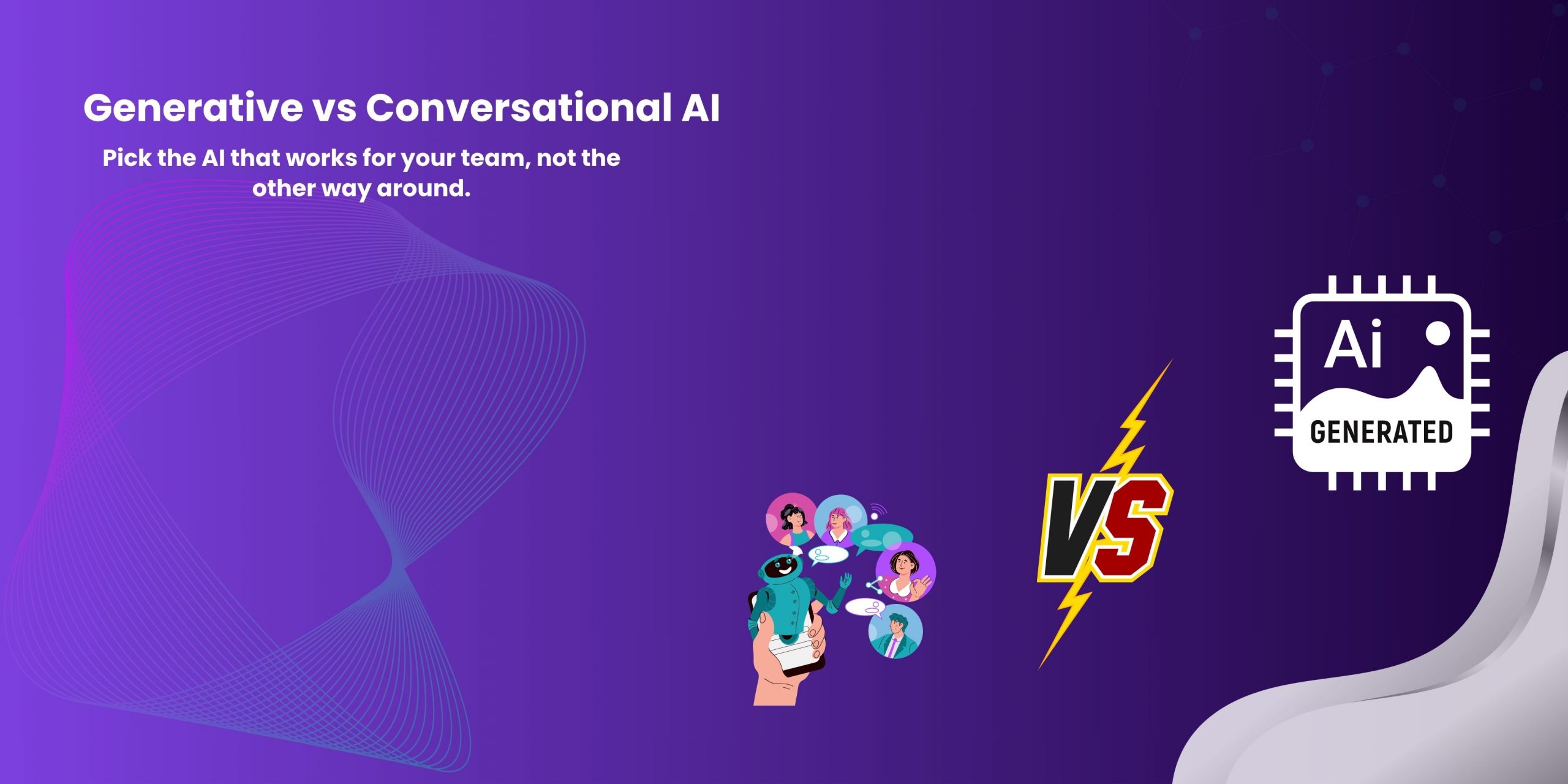You’ve got tasks piling up. Your team is overworked. You know AI can help, but choosing the right kind? That’s the tricky part.
Some tools chat. Some tools are created. Some claim to do everything.
And if you pick the wrong one, it might slow you down instead of speeding things up.
You’re not alone.
Nearly 73% of companies are adding AI to their processes, but over 40% say they’re still not sure how to choose between AI types.
That’s why we’re here.
In this blog, we’ll break down conversational AI vs generative AI in the simplest, clearest way possible.
You’ll know exactly what each one does and when to use which, so you can move forward with confidence.
What Is Conversational AI?
Let’s start with the one you’ve probably used before.
Conversational AI is built to talk. It’s used in tools like AI chatbot systems, voice assistants, and live chat tools.
You ask a question. It gives a response. Sometimes short. Sometimes smart. Always quick.
What it’s good at:
- Answering user questions
- Guiding someone through steps
- Handling live chat support
- Replacing phone menus
- Booking or cancelling stuff automatically
Behind the scenes, it’s using natural language understanding, memory, and some light logic to talk like a human.
The focus here is on interaction, not creation.
What Is Generative AI?
Now let’s talk about the other kind, generative AI.
This one’s all about making things.
You give it a prompt or request, and it builds something from scratch. Could be text. It could be a picture. It could even be code.
It doesn’t just repeat back answers; it creates fresh content based on patterns it has learned.
What it’s good at:
- Writing emails or blog drafts
- Creating product descriptions
- Summarizing long reports
- Designing simple images
- Generating ideas or outlines
Generative AI looks at examples, learns from them, and builds something similar but brand new.
Conversational AI Vs Generative AI: What Is the Difference Between Them?
Let’s make it super clear.
| Feature | Conversational AI | Generative AI |
| Main Purpose | Create content. | Writing, summarizing, and design |
| Good At | Chat, help, Q&A | Writing, summarizing, and designing |
| User Input | Questions or commands | Prompts or topics |
| Output | Dialogue or answers | Content or ideas |
| Common Tool | AI chatbot | Content generator |
So if you need a tool to talk to users, go conversational.
If you need something to write or build, go generative.
When to Use Conversational AI
You should go with conversational AI when your users:
- Need quick help
- Are you asking common questions?
- Want to check the status or book something?
- Don’t want to wait on human agents
It’s perfect for:
- Customer service chatbots
- Virtual assistants
- Voice commands
- Guided app flows
Basically, anytime you want smooth, smart interaction without human support.
When to Use Generative AI
Now, pick generative AI when your team needs to:
- Write things fast.
- Create lots of short content.
- Brainstorm ideas.
- Summarize documents.
- Personalize messages.
It helps in marketing, support, product, and even HR.
You give it a few words, and it gives you back a full draft, paragraph, or design.
It saves hours and frees up your team for bigger tasks.
Can You Use Both Together?
Yes, and that’s where things really get powerful.
For example:
- A chatbot talks to a user (conversational AI).
- It collects their question.
- Then it asks generative AI to create a smart reply.
- And sends it back in real time
Now your system talks and creates—without manual input.
This combo gives users a better experience and helps your team work faster.
Where Most Businesses Get It Wrong: Choosing Conversational AI vs Generative AI
A few mistakes pop up often. Here’s what to avoid:
1. Using the wrong tool for the job
Trying to use a chatbot to write blog posts? Nope.
Using a writer tool to hold a conversation? Won’t work.
2. Poor data
Both AI types need good, clean info. If your input’s messy, the output will be worse.
3. No long-term plan
AI works best when tied into your full process.
That’s why companies team up with an artificial intelligence development company to build it right the first time.
How These Tools Fit into Daily Workflows
Here’s what real companies are doing today:
- E-commerce: Chatbots handle support, and generative AI writes product copy.
- Finance: Virtual agents check balances, and AI writes reports or summaries.
- Healthcare: Conversational tools gather symptoms, and generative AI builds patient notes.
- SaaS: AI chats with users, then creates tutorials, emails, or updates.
The goal? Save time. Reduce manual work. Serve users better.
How to Get Started the Right Way
Starting with AI doesn’t have to be hard. Here’s how:
Step 1: Know what problem you’re solving.
Need to chat or create? Choose based on that.
Step 2: Set one goal.
Start small. One process, one tool.
Step 3: Use clean data.
Even the best AI can’t fix bad info.
Step 4: Build with experts
Look for teams offering machine learning development services to guide your tech setup.
Step 5: Measure and improve.
Test it, use it, then make it better.
Why This Ties into New Tech Trends
This kind of smart automation isn’t a passing trend.
It’s part of the bigger wave of new trends that are changing how teams work across industries.
From AI-powered analytics to voice-led apps, businesses that move early have a clear edge.
And here’s the real deal: tech is evolving fast. What worked two years ago might be outdated today. By understanding which AI solution fits your workflow now, you’ll future-proof your operations and stay flexible as trends shift.
AI doesn’t mean replacing your team. It means helping your team do more in less time, with fewer headaches and better results. That’s what today’s growth looks like.
What to Expect from Generative AI Services
If you want real content generation at scale, it’s time to explore Generative AI Development Services.
Here’s what you’ll get:
- Fine-tuned models built for your business
- Smart tools inside your own apps or dashboards
- Training, support, and updates
- Secure, scalable systems that grow with you
Whether you need blog posts, chat replies, or dynamic web content, this service helps you do it faster and better.
And the best part? It never stops learning. With each use, the system improves.
That means your tools keep getting smarter without extra work from your side.
Final Thoughts: Choose the Right AI Tool for the Job
To wrap it up:
- Conversational AI helps you talk with users.
- Generative AI helps you create smart content.
- Together, they make your business smarter, faster, and more helpful.
Use chatbots to connect. Use writers to scale content. Use both to stay ahead of the curve.
That’s the smart way to do AI in 2025.
Ready to move forward with the right kind of AI?
Start small. Pick the right path. And grow with confidence.



